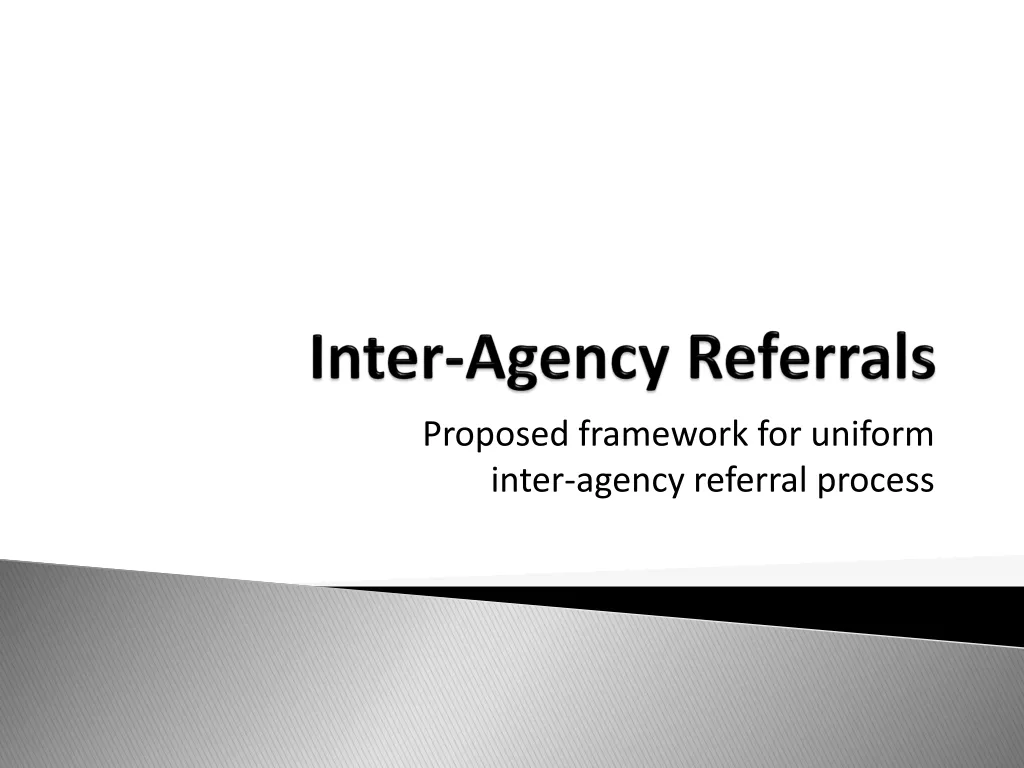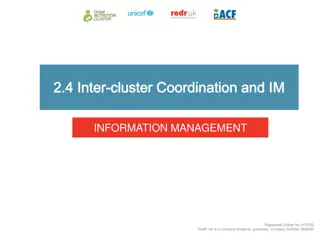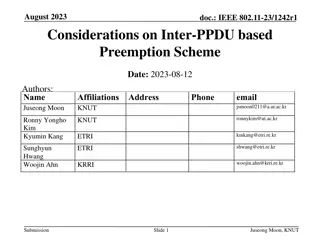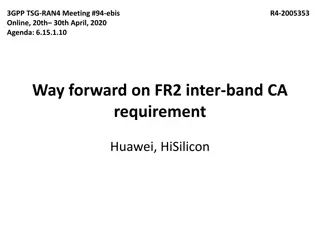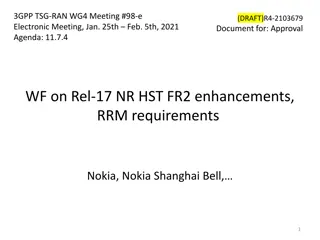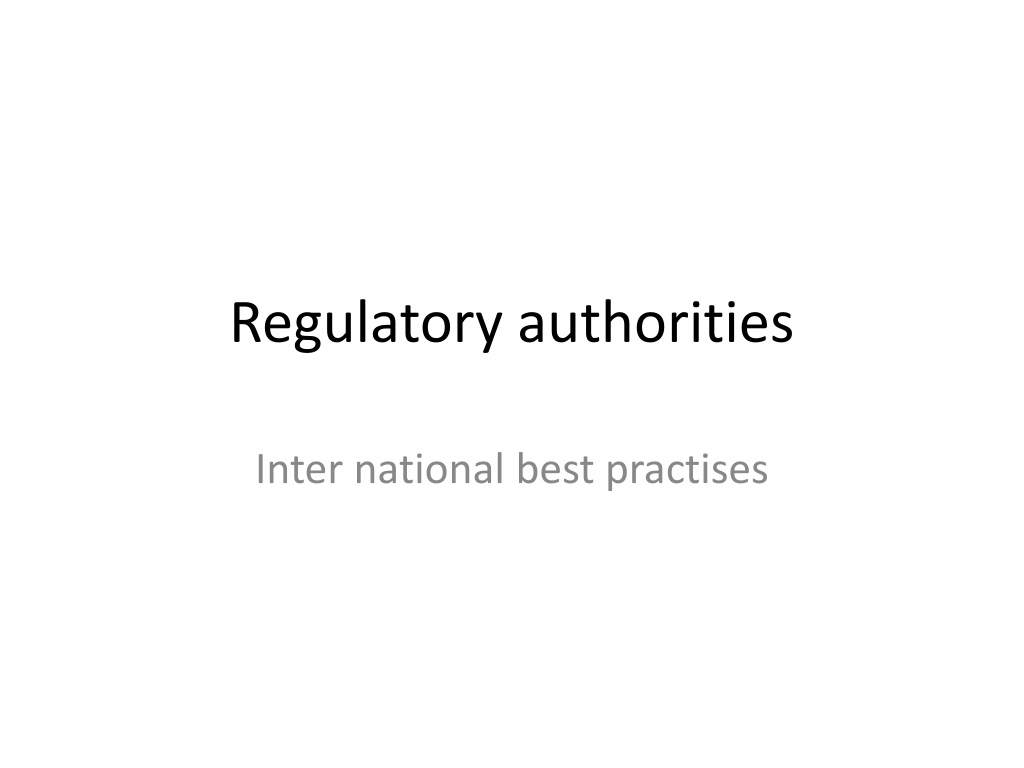
Evolution and Principles of Regulatory Authorities
Discover the history of regulatory agencies, from the inception of the Interstate Commerce Commission in the USA to the establishment of various regulatory bodies. Learn about the key principles guiding regulatory decisions and the aims for better regulatory arrangements to ensure fairness, consistency, and effectiveness in governance.
Download Presentation

Please find below an Image/Link to download the presentation.
The content on the website is provided AS IS for your information and personal use only. It may not be sold, licensed, or shared on other websites without obtaining consent from the author. If you encounter any issues during the download, it is possible that the publisher has removed the file from their server.
You are allowed to download the files provided on this website for personal or commercial use, subject to the condition that they are used lawfully. All files are the property of their respective owners.
The content on the website is provided AS IS for your information and personal use only. It may not be sold, licensed, or shared on other websites without obtaining consent from the author.
E N D
Presentation Transcript
Regulatory authorities Inter national best practises
Brief history The notion of the regulatory agency was initiated in the USA and it has been basically an American establishment The first agency was Interstate Commerce Commission (ICC), established by Congress in 1887 to control the railroads Initially, the ICC was to serve only as an advisory body to Congress and the courts, but it was soon granted these powers itself. First step taken to control industries instead of taking each on a case-by-case basis, as had been previously done.
Brief history Contd.- many other regulatory agencies modeled upon the ICC, chief among these being the Federal Trade Commission (FTC, 1914), Federal Communications Commission (FCC, 1934), and Securities and Exchange Commission (SEC, 1934) Regulatory agencies are generally a part of the executive branch of the government, or they have statutory authority to execute their functions with oversight from the legislative branch Their actions are generally open to legal review. Regulatory authorities are usually established to implement standards and safety, or to oversee use of public goods and regulate business.
Basic principles a consistent policy covering the role of functions of regulatory agencies in order to provide greater confidence that regulatory decisions are made on an objective, impartial and consistent basis, without conflict of interest, bias or improper influence.
Aims for better regulatory arrangements Serve clearly identified policy goals, and be effective in achieving those goals Have a sound legal and empirical basis Produce benefits that justify costs, considering the distribution of effects across society and taking economic, environmental and social effects into account Minimise costs and market distortions Promote innovation through market incentives and goal-based approaches Be clear, simple and practical for users Be consistent with other regulations and policies Be compatible as far as possible with competition, trade and investment-facilitating principles at domestic and international levels
Governance arrangements of regulators
Necessary elements of better regulatory outcomes Well-designed rules and regulations that are efficient and effective Appropriate institutional frameworks and related governance arrangements Effective, consistent and fair operational processes and practices High quality and empowered institutional capacity and resources, especially in leaderships
Best practice principles Role clarity Preventing undue influence and maintaining trust Decision-making and governing body structure for independent regulators Accountability and transparency Engagement Funding Performance evaluation
Role Clarity An effective regulator must have clear objectives, with clear and linked functions and the mechanisms to co-ordinate with other relevant bodies to achieve the desired regulatory outcomes
Principles for role clarity Objectives The legislation establishing a regulatory scheme or framework should be written so that the purpose of the regulator and the objectives of the regulatory scheme are clear to the regulator s staff, regulated entities and citizens. Functions The regulatory powers and other functions to be carried out to achieve the regulator s objectives should be clearly specified in the establishing legislation and be appropriate and sufficient to achieving the objectives. Regulators should not be assigned conflicting or competing functions or goals. The assignment of potentially conflicting functions to any regulator should only occur if there is a clear public benefit in combining these functions and the risks of conflict can be managed effectively. Where a regulator is given potentially conflicting or competing functions, there should be a mandatory mechanism whereby conflicts arising are made transparent and processes for resolving such conflicts are specified. There should also be legal ground for co-operation and protocols between relevant regulators or bodies.
Principles for role clarity Contd- Where a regulator is assigned competing functions, the legislation should provide a framework to guide the regulator in making trade-offs between the functions, or require the regulator to develop such a framework with the necessary bodies (e.g. legislature, executive, and judiciary). Regulators should operate within the powers attributed to them by the legislature and legislation should provide for judicial review for actions that might be held to be ultra vires (beyond the scope of the regulator). At the same time the scope of the regulator should recognise where appropriate discretion is needed in the way that regulatory powers are to be interpreted by the regulator to meet its objectives, without engaging in mission creep . The responsibility for setting or advising on government policy, particularly relating to the nature and scope of the regulator s powers and functions, should not principally sit only with the regulator even though the regulator has the most up to date knowledge of the issues in the regulated sector. The principal responsibility for assisting the executive to develop government policy should sit with the responsible executive agency and the regulator should have a formal advisory role in this task. In all cases such policy should be advanced in close dialogue with affected regulatory and other agencies, and there should be specified mechanisms for regulators to contribute to the policy-making process.
Principles for role clarity Contd- Co-ordination To reduce overlap and regulatory burden, all regulators should be explicitly empowered and required to co-operate with other bodies (non-government and other levels of government) where this will assist in meeting their common objectives. In the interests of transparency, instruments for co- ordination between entities, such as memoranda of understanding, formal agreements or contracts for service provision, should be published on regulators websites, subject to the appropriate removal of information (for example, that which is commercial-in-confidence).
Preventing undue influence and maintaining trust It is important that regulatory decisions and functions are conducted with the upmost integrity to ensure that there is confidence in the regulatory regime. This is even more important for ensuring the rule of law, encouraging investment and having an enabling environment for inclusive growth built on trust
Preventing undue influence and maintaining trust there is a need for the regulator to be seen as independent, to maintain public confidence in the objectivity and impartiality of decisions; both government and non-government entities are regulated under the same framework and competitive neutrality is therefore required; or the decisions of the regulator can have a significant impact on particular interests and there is a need to protect its impartiality.
Preventing undue influence Independent regulatory decision making at arm s length from the political process, is likely to be appropriate where: there is a need for the regulator to be seen as independent, to maintain public confidence in the objectivity and impartiality of decisions; both government and non-government entities are regulated under the same framework and competitive neutrality is therefore required; or the decisions of the regulator can have a significant impact on particular interests and there is a need to protect its impartiality; the autonomy of regulators (organisational, financial and decision making) situated within a ministry should be safeguarded by provisions in their empowering legislation. All regulators should operate within the power delegated by the legislature and remain subject to long term national policy.
Preventing undue influence Contd- New or major policy decisions should be justified by the regulator based on an empirical basis and in the light of evaluation of previous measures, and the reasoning should be made publicly available. Regulators shall conduct horizon scanning of potential major issues and give prior notice to regulated entities and the public of any new major policy initiatives and allow reasonable period for genuine comment by stakeholders, as well as feedback from the regulator. Board members, senior staff and staff on secondment should not be involved in any decisions that affect previous employers. In cases where exceptions are made to a regulated entity, this should be notified to all regulated entities, the public, minister and legislature.
Maintaining trust Where legislation empowers the minister to direct an independent regulator, the limits of the power to direct the regulator should be clearly set out. The legislation should be clear about what can be directed and when. Any communication between the minister, the ministry and an independent regulator should occur in a way that does not compromise the actual or perceived independence of regulatory decision making. The criteria for appointing members of a regulator s governing body, and the grounds and process for terminating their appointments, should be explicitly stated in legislation.. Government and or the legislature should establish and publish for each regulator a policy (such as cool-off periods) relating to post- separation employment of senior regulatory staff and members of the regulator s governing body.
Independence in decision making can also be fostered by a number of means including: operational clarity clear articulation of decision-making power in legislation; clarity about requirements for reporting to the minister; definition of the minister s power to direct the regulator and transparent processes around the issuing of directions an adequate resource base staffing flexibility to attract and retain competent specialised staff for certain regulatory functions; transparent processes for appointment to governing bodies and chief executive positions; explicit provisions covering performance criteria and review; explicit conditions and transparent processes for appointment and termination of appointments, including appeals processes; and limitations or restrictions on members of the regulator s governing body accepting employment in the regulated industry after leaving the regulator ( post-separation activities).
Independence in decision making Regulators require governance arrangements that ensure their effective functioning, preserve its regulatory integrity and deliver the regulatory objectives of its mandate
Principles for decision making and governing body structure Decision-making model The governing body structure of a regulator should be determined by the nature of and reason for the regulated activities and the regulation being administered, including its level of risk, degree of discretion, level of strategic oversight required and the importance of consistency over time. Relationship between the responsible accountable political authority, governing body and the Chief Executive Officer There should be a clear allocation of decision making and other responsibilities between the responsible accountable political authority, the governing body and the Chief Executive Officer (CEO) or individual in charge of the organisation s performance and implementation of decisions. Where a regulator has a multi-member governing body, the CEO or individual responsible for managing the organisation s performance and implementing regulatory decisions should be primarily accountable to the regulator s governing body.
Membership of the governing body To avoid conflicts of interest, where there is a need for formal representation of specific stakeholders in strategic decision making, stakeholder engagement mechanisms such as an advisory or consultative committee should be established, rather than making those stakeholders members of the regulator s governing body. Executive representatives are accountable to the minister, and their presence on the governing body of an independent regulator can create role conflict. They should only participate in meetings of the governing body of independent regulators in a non- voting capacity and only when necessary and by invitation of the regulator. The role of members of the governing body who are appointed for their technical expertise or industry knowledge should clearly be to support robust decision making in the public interest, rather than to represent stakeholder interests. Policies, procedures and criteria for selection and terms of appointment of the governing body should be documented and readily available to aid transparency and attract appropriate candidates. Members of the governing body should be limited to the number of terms of appointment to the Board.
Governance structures Governance board model the board is primarily responsible for the oversight, strategic guidance and operational policy of the regulator, with regulatory decision making functions largely delegated by the chief executive officer (CEO) and staff Commission model the board itself makes most substantive regulatory decisions Single member regulator an individual is appointed as regulator and makes most substantive regulatory decisions and delegates other decisions to its staff.
Membership of the governing body Stakeholder representation Ministry representation on the governing board Technical expertise or industry knowledge
Accountability and transparency Businesses and citizens expect the delivery of regulatory outcomes from government and regulatory agencies, and the proper use of public authority and resources to achieve them
Principles for accountability and transparency Accountability and transparency to the minister and the legislature The expectations for each regulator should be clearly outlined by the appropriate oversight body. These expectations should be published within the relevant agency s corporate plan. Regulators should report to ministers or legislative oversight committees on all major measures and decisions on a regular basis and as requested. Governments and/or the legislator should monitor and review periodically that the system of regulation is working as intended under the legislation. In order to facilitate such reviews the regulator should develop a comprehensive and meaningful set of performance indicators.
Accountability and transparency to regulated entities Information and access to appeal processes and systems should be made easily available to regulated entities by regulators. Regulators should establish and publish processes for arm s length internal review of significant delegated decisions (such as those made by inspectors). Regulated entities should have the right of appeal of decisions that have a significant impact on them, preferably through a judicial process. Such right of appeal shall be allowable, inter alia, on the grounds that the regulator has exceeded the powers attributed to it, insufficiency of consultation, and/or material omissions in the evidence and actions that are disproportionate to the issue being addressed. Regulators may rescind decisions as a result of appeal.
Accountability and transparency to the public Key operational policies and other guidance material, covering matters such as compliance, enforcement and decision review, should be publicly available. The regulator should recognise its special responsibility in ensuring that members of the public have channels of complaint and possible redress in relation both to the actions of a regulated entity and to the actions of the regulator. All major decisions made by the regulator shall be accompanied by publicly stated reasons. The opportunity for independent review of significant regulatory decisions should be available in the absence of strong public policy reasons to the contrary. The right of appeal of decisions by the regulator should be extended to members of the public where their standing is recognised by the judiciary.
Engagement Good regulators have established mechanisms for engagement with stakeholders as part of achieving their objectives. The knowledge of regulated sectors and the businesses and citizens affected by regulatory schemes assists to regulate effectively
Principles for engagement Fit for purpose Regulators should undertake regular and purposeful engagement with regulated entities and other stakeholders focused on improving the operation and outcomes of the regulatory framework or scheme. Procedures and mechanisms for engagement should be institutionalised as consistent transparent practices. There should be a focus on establishing structured and regular consultation mechanisms with regulated entities. Avoiding capture and conflicts of interest Engagement processes used should protect against potential conflicts of interests of participants and guard against the risk that the regulator may be seen to be captured by special interests.
Funding The amount and source of funding for a regulator will determine its organisation and operations. It should not influence the regulatory decisions and the regulator should be enabled to be impartial and efficient to achieve its objectives.
Principles for funding Supports outcomes efficiently Funding levels should be adequate to enable the regulator, operating efficiently, to effectively fulfill the objectives set by government, including obligations imposed by other legislation. Funding processes should be transparent, efficient and as simple as possible. Regulatory cost recovery Regulators should not set the level of their cost recovery fees, or the scope of activities that incur fees, without arm s-length oversight. These fees and the scope of activities subject to fees should be in accordance with the policy objectives and fees guidance set by government or, where these are not in place, the OECD s Best Practice Guidelines for User Charging for Government Services (OECD, 1998). Where cost recovery is required, the regulator should not be at risk of setting unnecessary or inefficient administrative burdens or compliance costs on regulated entities.
Litigation and enforcement costs Because of the significant and unpredictable costs involved, regulators should follow a defined process to obtain funding for major unanticipated court actions in the public interest that is consistent with the degree of independence of the regulator. Funding of external entities by a regulator A regulator should only fund other entities to deliver activities where they are directly related to the regulator s objectives, such as information and education about how to comply with regulation, or research to inform the regulator s priorities. Any funding of representative or policy advocacy organisations should be the responsibility of the relevant ministry, not the regulator.
Performance evaluation It is important that regulators are aware of the impacts of their regulatory actions and decisions. This helps drive improvements and enhance systems and processes internally. It also demonstrates the effectiveness of the regulator to whom it is accountable and helps to build confidence in the regulatory system
Principles for performance evaluation Identifying the scope Regular independent external reviews of regulators should be arranged by the government, legislature or the regulator itself, in addition to any internal reviews. Regulators should clearly define and agree the scope of their mandate that will be assessed with key stakeholders. This may already be contained within legislation. Regulators should determine which regulatory decisions, actions and interventions will be evaluated in the performance assessment. Regulators should conduct a periodic review of regulations that are put into effect after a number of years of implementation (post- implementation reviews). More broadly; regulators should evaluate their activities and decisions on a continuing basis in the light of their legislative mandate and taking into account the views of outside interested parties.
Principles for performance evaluation contd.- Developing indicators Regulators should consider which operational indictors can be used to demonstrate the systems, processes and procedures that are applied within the organisation to complete the tasks of the regulator e.g. following published procedures are satisfactory and appropriate. Regulators should consider which outcome indicators can be linked to the actions of the regulator to demonstrate the overall strategic results of regulatory interventions in relation to operations e.g. investment in infrastructure. Comparisons and peer expertise and evaluation should be utilised.
Principles for performance evaluation contd.- Use of performance evaluation The main purpose of the performance evaluation should be to maintain and drive improvements in the performance of the regulator. The performance evaluation criteria and results should be published. The performance evaluation criteria should be reflected in performance assessments of staff in the regulator, where possible.
Case Study ACCC & AER The Australian Competition & Consumer Commission (ACCC) and the Australian Energy Regulator (AER) are both independent Commonwealth statutory agencies. The Competition and Consumer Act 2010 (the CCA) establishes a Commission and Board as the respective decision-making bodies for the ACCC and AER. The Australian Governor-General may only terminate the appointment of members of the Commission in very limited circumstances Commissioners and Board members are initially engaged for five year terms and may seek re- appointment at the conclusion of their terms. Relevant minister can not give directions to the ACCC under a significant range of the regulatory activities and responsibilities undertaken by the ACCC.
Case Study ACCC & AER Contd.- ACCC and AER each maintain websites containing a broad and detailed range of documents to assist stakeholders in understanding the nature of their work. The ACCC and AER provide public versions of all draft and final regulatory determinations on their website. In addition to these transactional documents, the ACCC and AER both produce guidance for stakeholders on operational policies. The ACCC and The AER publishes a Compliance and Enforcement Policy which sets out the principles adopted by them to achieve compliance with the law. In addition to this type of guidance, the ACCC provides stakeholders with details on its decision-making processes, including the structure of its specialised committees, and its Code of Conduct for Commission members
Case Study ACCC & AER Contd.- The AER has released Strategic priorities and work programme Outlining four strategic priorities and five distinct areas of the work programme , listed target deliverables and performance indicators for each strategic priority and programme area publishing performance indicators in this annual document. In September 2013, the AER released its first inaugural annual report The AER has established indicators that cover the breadth of its work. Some of these indicators are objectively quantifiable, while others are quite subjective. Similarly, some indicators are specific deliverables with no measure of quality, while others rely on perceptions of the AER.

